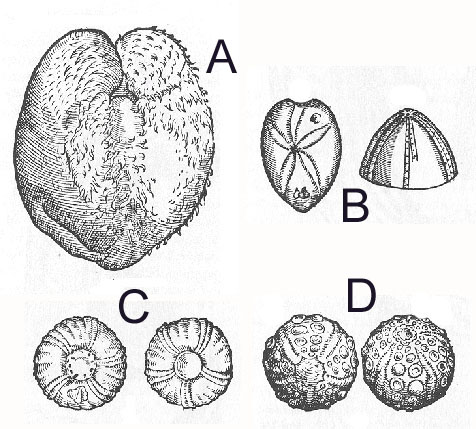

 | CONRAD GESNER: After Xenophanes the significance of fossils went unrecognized for a very long time. Only occassionally did glimpses of the true meaning of fossils surface, by such major figures as Xanthos of Sardis about the time of Aristotle (350 BC); and by Leonardo da Vinci (1452-1519) in the 15th century (Leonardo's only known self-portrait is seen at left). The main problem impeding a proper view of the meaning of fossils was that resemblances of lithified objects to living organisms were not often obvious, and even when they were there was no good reason for asserting that the resemblance was anything but fortuitous. There were, in other words, no sure criteria for recognizing and distinguishing fossils from inorganic objects, i.e., from objects that derived from inanimate things rather than from pre-existing organisms. |
 | Conrad Gesner (1516- 1565) came as close to the correct view as any early natural historian. At left is an illustration from Gesner's 1565 book, On Fossil Objects, in which he found the physical similarity between the modern sea urchin (A), and a lithified heart urchin (B) so clear that the organic origin of the heart urchin could not be denied - that it was a fossil in the modern sense of the word. However, the two lithified regular urchins (C&D) differed in a number of details from the modern analog (note that they are rounder) so that Gesner felt they were not similar to the modern urchin and thus had an inorganic origin (he was wrong about that, there are modern regular urchins like the two fossils in pictured C&D). The absence of a yardstick for assessing the organic nature of lithified objects; the misapprehension of the great age of the earth; and because the mechanism of fossil preservation was unclear (Gesner's main difficulty), the arguments of visionaries like Da Vinci and Gesner, imperfect as they were, fell on deaf ears. |